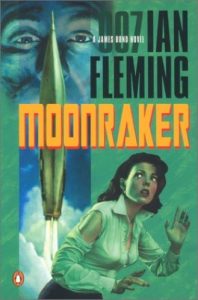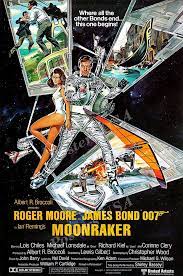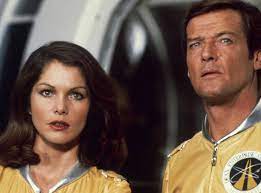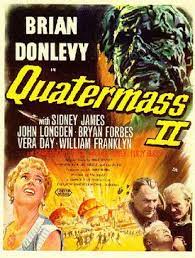
© Vintage Books
First published in 1962, The Spy Who Loved Me is the ninth of Ian Fleming’s James Bond novels and holds several records in the Bond literary canon. It clocks in at 198 pages, making it the shortest Bond book. It was also the last book to appear in a world that knew Bond as a literary and not a cinematic character, because its publication came just six months before the release of Dr No, the first Bond movie produced by Cubby Broccoli and Harry Saltzman. And it was the worst-received of the books. The Daily Telegraph reacted to it with a despairing “Oh Dear Oh Dear Oh Dear!”, the Listener dismissed it as ‘unremittingly’ and ‘grindingly boring’ and the Observer demanded, “why can’t this cunning author write up a bit instead of down?”
Once the critics had stuck in their knives, Fleming himself disowned the book. He asked his publisher not to print a paperback edition of it, a request honoured until two years after his death. He also stipulated that any movie version of The Spy Who Loved Me could never use the book’s plot, only its title.
I’m sure that 15 years later when Cubby Broccoli got around to filming The Spy Who Loved Me, he was distraught about this. “You mean,” lamented the cigar-puffing mogul, “I can’t follow what happens in the book? I have to put other stuff in my movie instead? Like cars that travel underwater? Giant oil-tankers that swallow nuclear submarines? Roger Moore skiing over a clifftop and saving himself with a Union Jack parachute? No! NO!”

© Eon Productions
Well, I’ve finally read the original, much-maligned The Spy Who Loved Me. My initial reaction was Ian Fleming at least deserved credit for venturing off the beaten track. Fans of his previous eight books were surely surprised when they started reading it in 1962 and discovered they were hearing a first-person narrative voice rather than Fleming’s usual, authoritative, third-person one. “I was running away,” it begins. “I was running away from England, from my childhood, from the winter, from a sequence of untidy, unattractive love-affairs, from the few sticks of furniture and jumble of overworn clothes that my London life had collected around me; and I was running away from the drabness, fustiness, snobbery and claustrophobia of close horizons and from my inability, though I am quite an attractive rat, to make headway in the rat-race. In fact, I was running away from almost everything except the law.”
The first-person voice is that of Viv Michel, a young French-Canadian woman who’s been left in charge of a closed-for-the-winter motel called The Dreamy Pines Motor Court in the mountains of northern New York State. After a first chapter where Viv doesn’t cope well with a thunderstorm raging above the motel’s empty cabins, playground, swimming pool and golf range – she stupidly pulls an electrical switch at the same moment that a bolt of lightning lets rip, and the resultant electrical shock knocks her unconscious – she spends the next eighty pages explaining how she’s ended up in this situation.
She describes her early life in Canada; being sent to a finishing school in England where she “was made to suffer agonies” for her accent, for her table manners “which were considered uncouth”, for her “total lack of savoir-faire and, in general, for being a Canadian”; and finding work in London while suffering the afore-mentioned “sequence of untidy, unattractive love affairs”. After the last affair results in her having an abortion in Switzerland, she returns to North America, where she resolves to search for adventure and self-discovery and shake off the memories of the men who’ve used and abused her. So she purchases a Vespa 150cc Gran Sport and sets off on a road trip. It’s on the road that she comes across the Dreamy Pines Motor Court, where she gets offered employment; first as an end-of-season receptionist and then, when it closes for the winter, as a caretaker minding the premises until its owner, one Mr Sanguinetti, arrives to take possession of the keys.
Viv’s position at the Dreamy Pines feels slightly like that of Jack Torrance at the Overlook Hotel in Stephen King’s The Shining (1977) and things soon go as badly for her as they did for the ill-fated Jack. Two hoodlums with the nicknames Sluggsy and Horror show up at the motel in the middle of the night and take her prisoner. It transpires that Sanguinetti is a gangster and the pair are henchmen tasked with burning the place to the ground as part of an insurance scam. Viv, the only witness, looks likely to be torched along with the motel.
It’s here that we encounter the single detail of the book that makes it into the 1977 film ‘adaptation’ with Roger Moore. Looking at Horror’s face, she notices “a glint of grey silvery metal from his front teeth,” indicating that “they had been cheaply capped with steel.” Sound familiar?

© Eon Productions
By now we’re more than halfway into the book. Back in 1962 at this point, readers must have been panicking: where the hell is Bond? Well, he appears at The Dreamy Pines later that same night – Viv’s first impression of him is that he’s “good-looking in a dark, rather cruel way” with a scar that “showed whitely down his left cheek” – and he explains that his car has suffered a flat tyre on the road nearby and he’d like to get a room. He soon wises up to the situation and joins forces with Viv. The next seventy pages play more like a Mickey Spillane novel than a Fleming / Bond one, with considerable running, hiding and shooting before Sanguinetti’s scheme is thwarted and Sluggsy and Horror end up dead at the bottom of the local lake. Then Viv and Bond indulge in some love-making and then, as abruptly and enigmatically as he arrived, Bond slips off again. In the final pages, Viv muses: “He was just a man who had turned up at the right time and then gone on his way.”
Though The Spy Who Loved Me wins kudos for bravely departing from the usual Bond formula, there are moments when seemingly Fleming remembers it’s still a Bond novel and is forced to compromise, with awkward results. He wants Viv to be more believable than the average Bond girl, which is why we see her depicted as a working Londoner. But on the other hand, as a Bond girl, she can’t be too ordinary so she also gets a French-Canadian back-story to make her appear more exotic – the overall effect of which feels contrived. Also, while Fleming wants her to be feisty and independent, he needs her to have a vulnerable side too – to be a credible damsel-in-distress, for whom Bond rides to the rescue as a knight in shining armour. That may explain the opening chapter where she panics during the storm and, frankly, comes across as a dolt.
And to make up for Bond’s late entrance into the plot, Fleming feels obliged to bring his readers up to speed on what Bond’s been doing in the meantime; so we get the telling of a previous Bond adventure. In a twelve-page chapter entitled Bedtime Story, Bond explains to Viv in detail how he ended up on the road that night. He was driving south after an operation in Toronto wherein he and the Canadian Mounties prevented the assassination of a Russian defector by the KGB and SPECTRE. By this point, Bond and Viv know the extreme danger posed by Sluggsy and Horror, so you’d think they’d have other things to focus on besides telling stories.
One thing I found surprisingly impressive about The Spy Who Loved Me is Viv’s account of her love-life in London. It’s as far removed as possible from the fantasy romance / sex scenes associated with the Bond novels. Just out of school, she gets involved with a youth called Derek Mallaby, whose posh, confident veneer hides, temporarily, the fact that (a) he’s desperate for sex and (b) he’s clueless about how to have sex. What follows is a painful tale set in the England of “drabness, fustiness, snobbery and claustrophobia” that existed before the 1960s started swinging and the permissive era arrived. The only privacy Viv and Derek can find for making love is in a small balcony-box at a cinema, “a meagre-looking place, showing two westerns, a cartoon and so-called ‘News’ that consisted of what the Queen had been doing a month ago.” Their attempted lovemaking, on the floor with Derek on top “in a dreadful clumsy embrace”, is anything but sensual and ends abruptly when a furious cinema manager bursts in on them: “Filthy little brats…! I’ve a damned good mind to call the police. Indecent exposure. Disturbing the peace.”
Barely articulate about what they’re trying to do, relying on strained expressions like ‘doing it’ and ‘being a sport’, and not even knowing what a condom is called and having to describe it to a shop assistant as “one of those things for not having babies”, Viv and Derek are products of a repressed, joyless, monochrome Britain that the Bond novels, with their exotic glamour and glitzy hedonism, were supposed to give readers of the era an escape from. No wonder The Spy Who Loved Me pissed so many of those readers off.
Once Viv and Derek have properly ‘done it’ a few times, Derek proves to be a cad and dumps her. She then gets into a second relationship with a German man called Kurt, which culminates in her getting pregnant, having an abortion and being dumped a second time. Kurt “had inherited strong views about mixed blood… and when he married, it would be into the Teutonic strain.” Fleming’s well-known dislike of Germans is on full display here.
This part of the book is so interesting because it suggests Fleming, a writer not noted for his empathy with women, is trying for once to think outside his normal male-chauvinist box and identify with a female character having a hard time in a world populated with predatory, shitty men.
Alas, this is rendered null and void later when Bond, hardly un-predatory and un-shitty himself, turns up and Viv promptly goes doe-eyed and weak-kneed at the sight of him; implying that Viv’s problem wasn’t men, it was just the absence of a fully-fledged alpha male like Bond to satisfy / tame her.
And, late on, Fleming truly sabotages his cause when Viv comes out with this jaw-dropping assertion: “All women love semi-rape. They love to be taken.” These ten words have rightly earned Fleming and The Spy Who Loved Me much opprobrium and they undo whatever good work he did with his depiction of Viv earlier in the book. I’d like to say they show an attitude towards women that’s wildly and rightly out-of-date nowadays – but of course in these Trumpian times, the era of Andrew Tate and Conor McGregor, there’s probably loads of male influencer-wankers out there in the so-called ‘manosphere’ who’d agree with Fleming’s sentiment.
In the end, I have no reason to disagree with the many people who label The Spy Who Loves Me the weakest of the Bond novels. The contradiction at its heart, that it’s a Bond story and yet wants to be something other than a Bond story, makes it uneven and inconsistent. And it’s all over the place in its sexual politics and, at worst, those politics are unspeakable.
But it deserves a little respect for attempting to do something out-of-the-ordinary, and thanks to Fleming’s always-amenable prose it’s an easy-enough read. And, in parts, hints of a better book glimmer through. It’s The Spy Who Tried Something Different.

© Penguin Books




